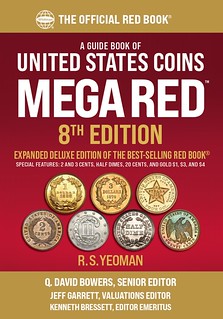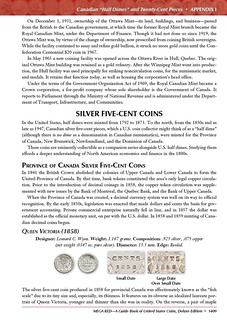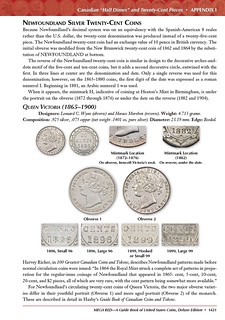
PREV ARTICLE
NEXT ARTICLE
FULL ISSUE
PREV FULL ISSUE
V25 2022 INDEX E-SYLUM ARCHIVE NEW BOOK: MEGA RED 8TH EDITION ADDS CANADIANThe eighth edition of Mega Red adds an appendix covering Canadian silver five cent and twenty-five cent pieces. Here's the announcement. -Editor
One of the book's 13 appendices covers two series of related Canadian coins—five-cent silver pieces (roughly analogous to U.S. half dimes), and twenty-cent pieces. The appendix is based on the work of James A. Haxby (author of Whitman's Guide Book of Canadian Coins and Tokens) and Harvey B. Richer (author of 100 Greatest Canadian Coins and Tokens).
Haxby discusses connections between the coinage of the two nations: In 1857 the Province of Canada's Currency Act of 1854 was revised to establish a decimal monetary system as the sole basis for its economy. Canada was confederated on July 1, 1867, when three British North American provinces—the Province of Canada, Nova Scotia, and New Brunswick—were united into the Dominion of Canada. The Province of Canada was split into Ontario and Quebec. (Since confederation, Canada has experienced numerous other territorial changes and expansions, resulting in the current constitutional monarchy under King Charles III, with ten provinces and three territories.) Appendix I of Mega Red, eighth edition, explores this history and the mints that produced Canadian five-cent and twenty-cent coins (the British Royal Mint, the Heaton Mint, and the Ottawa Mint).
It includes a coin-by-coin study of silver five-cent pieces of the Province of Canada, New Brunswick, Newfoundland, and the Dominion of Canada. In the United States, half dimes were minted from 1792 to 1873. To the north, Canadian silver five-cent pieces, which a U.S. coin collector might think of as a
The appendix similarly covers Canadian twenty-cent pieces. In the United States this denomination was minted in just four years, from 1875 to 1878. The Province of Canada had issued the same denomination nearly a generation earlier, in 1858. As with the Canadian Within the coin-by-coin study, the Mega Red appendix discusses technical specifications, mintages and mintmarks, die varieties, royal portrait variations, patterns and fantasies, individual Specimen coins, and related Specimen coin sets issued from 1858 to 1921.
Mega Red is billed as the
# # #
MEGA RED: A Guide Book of United States Coins, Deluxe Edition, 8th edition
Wayne Homren, Editor The Numismatic Bibliomania Society is a non-profit organization promoting numismatic literature. See our web site at coinbooks.org. To submit items for publication in The E-Sylum, write to the Editor at this address: whomren@gmail.com To subscribe go to: https://my.binhost.com/lists/listinfo/esylum All Rights Reserved. NBS Home Page Contact the NBS webmaster 
|



